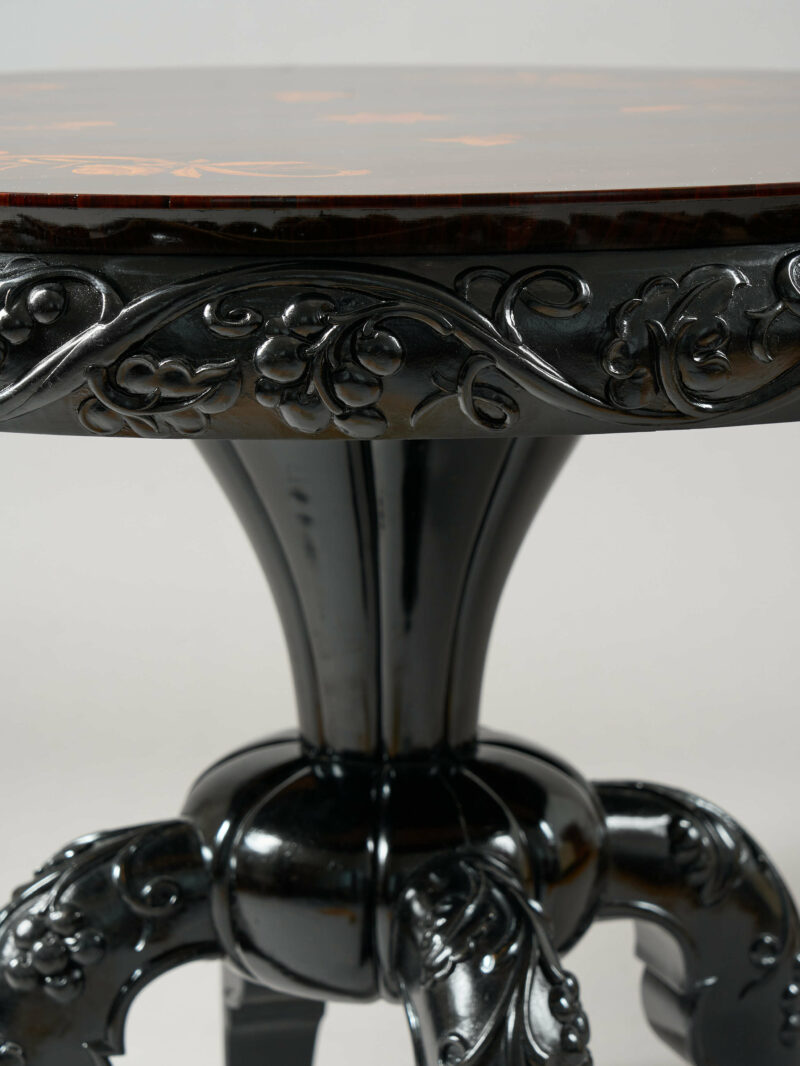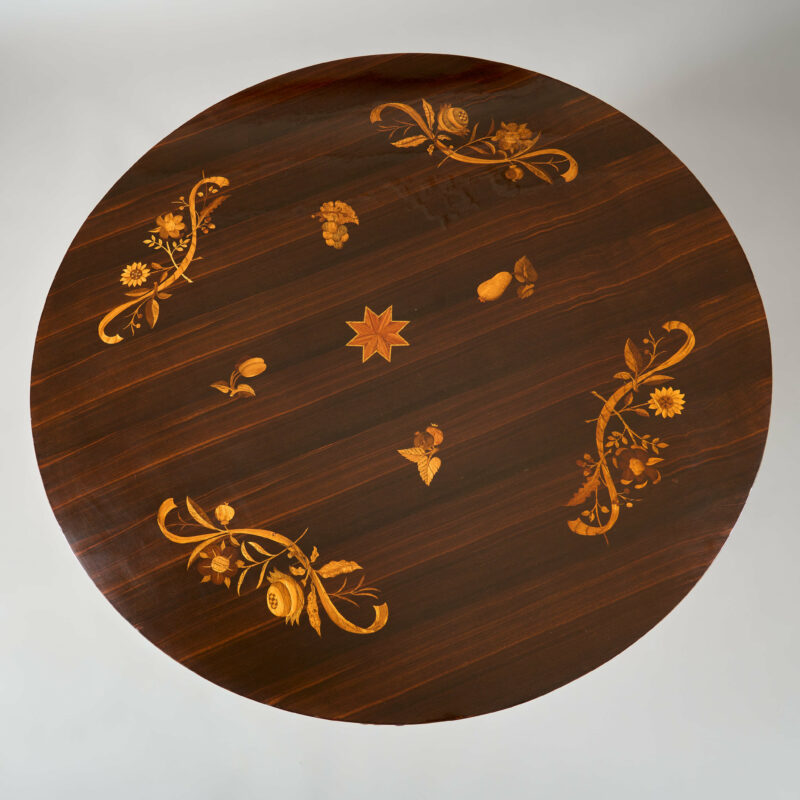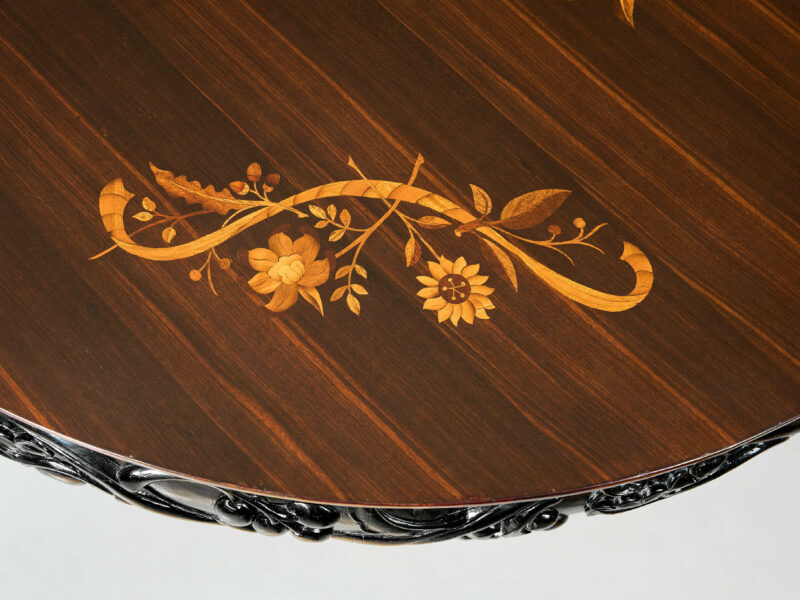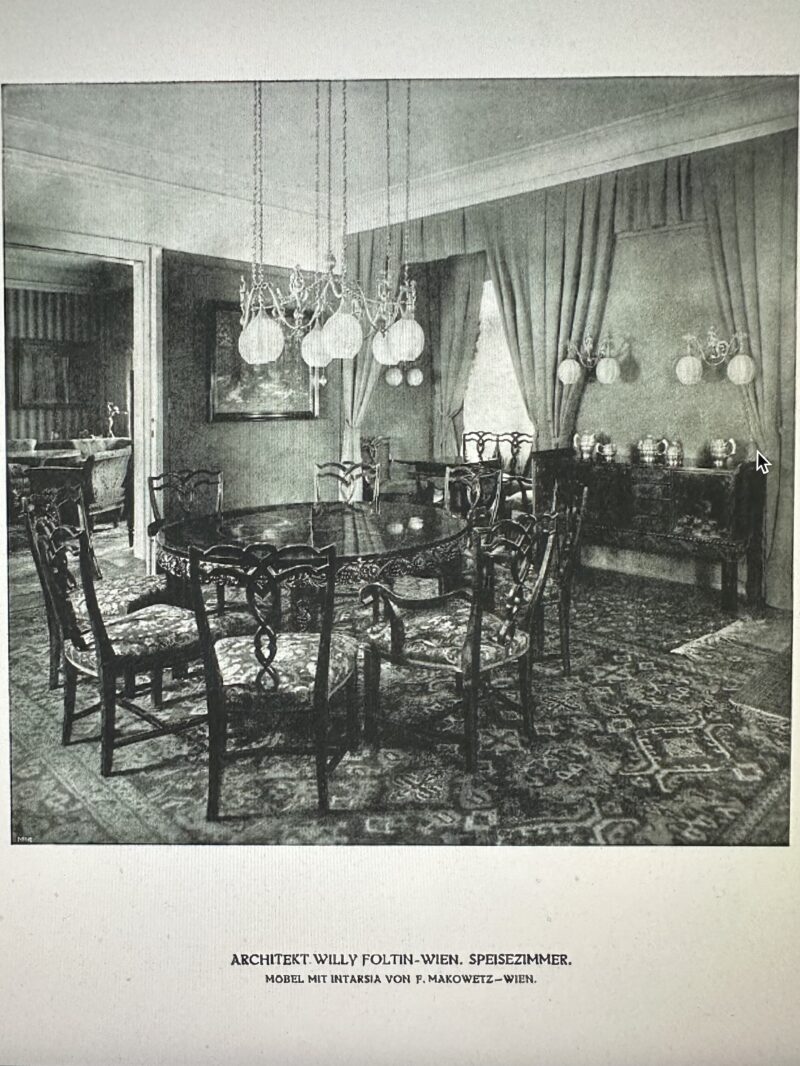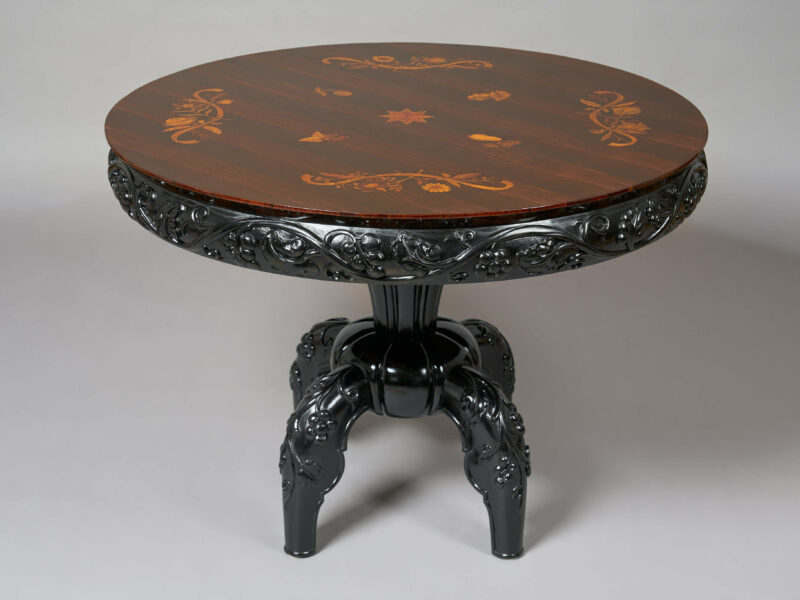
Salon or Entry Table by Wilhelm Foltin
Vienna 1920/1930; Design: Wilhelm Foltin, Execution: Johann Kutscherowsky, Intarsia: Makowetz
An extravagant and highly elaborate table design, which can be attributed to Wilhelm Foltin (1890 – 1970), a student of Josef Hoffmann. The craftsmanship is likely to have been executed by Johann Kutscherowsky, as was the case with the bedroom furniture Foltin designed for his wife, which is now part of the Hofmobiliendepot collection.
The intricate marquetry work was probably executed by Mr. Makowetz, similar to Foltin’s bedroom design.The round tabletop features a high, slightly recessed, convex apron richly carved with vine leaves and grapes. It is veneered in rosewood and polished with shellac, giving it a refined finish.
The four exquisitely inlaid floral arrangements consist of countless precious woods, depicting flowers, leaves, and fruits, each framed by an inlaid ribbon. Among the floral inlays, we find intarsia fruits, including pears, grapes, plums, and apples (possibly pomegranates). The center of the tabletop is adorned with an inlaid star motif.
The beautifully designed table base features an octagonal, tapering column composed of eight rounded segments, transitioning into a convex central element from which four curved legs emerge, each intricately carved with vine leaves and grape motifs.
This table is an exceptional and unique piece, demonstrating that Austria produced outstanding furniture in the 1920s. A comparable inlaid dining table with a vine and grape-carved apron can be found in an interior designed by architect Willy Foltin (see b&w image below).
A similar salon table has previously been part of our collection — see HERE for reference.Wilhelm Foltin (1890 — 1970):
He studied architecture under Professor Josef Hoffmann at the Vienna School of Arts and Crafts. Early in his career, he worked for the Wiener Werkstätte, designing fabrics. After his military service from 1914 – 1918, he studied under Alexander Popp at the Academy of Fine Arts in Vienna and also enrolled at the Vienna University of Technology. From 1918 to 1920, he worked in Josef Hoffmann’s architectural office. Foltin received his architectural diploma in 1940. He taught at the Academy of Furniture and Model Building from 1942 to 1944. His furniture and interiors were naturally influenced by the style of the Wiener Werkstätte. In 1966, Wilhelm Foltin was awarded the title of Professor.
Literature/References:
University Library Heidelberg / historical digital collections.“Die gesamte Wohnkunst in Bild und Wort” (“The Art of Living in pictures and text”), Editor: Hofrat Alexander Koch. XXXV Year January Issue, 1924, page 393.
“Innendekoration: Mein Heim, mein Stolz; Wohnen zwischen den Kriegen” (“Interior Décor: My Home, My Pride; Living between the two world wars”); Wiener Möbel 1914 – 1941 (Viennese Furniture)/ Museen des Mobiliendepots, pages 72 – 77
Below is an excerpt from the journal ‘Die gesamte Wohnkunst in Bild und Wort’, where Foltin shares his thoughts on architecture and interior design. This gives us a better understanding of the ideas that shaped the architecture and design style of this era:
Interior Design — Introduction:
Some Annotations:
A person’s home is a part of their life. Therefore, the task of the interior designer is to surround the client with furnishings that reflect their essence. Before constructing or furnishing a house or room, one should place the client metaphorically ‘in the middle of the room’ and clarify the relationship between them and the space, seeking to define the ‘physiognomy’ of the room.
Encourage the client to say, ‘Here I will work, here I will eat, here I will read my books, and here I will receive my guests.’ Try to understand how the client relates to life and art, and strive to accommodate their desires to the point where they feel at home in the new environment, almost forgetting the architect’s formative hand.
If the space already exists, examine doors and windows to determine if they can remain, as their placement is crucial for room division and light distribution. Wall treatment often significantly affects the room’s ambiance. With fabrics, avoid excessive gathering; opt for light fabrics that flow calmly and simply, forming natural folds. While furnishing items should be consistent in character, they need not be uniform in form.
Avoid consistent height measurements. The profile of the table should not match the profile of the cabinet at the same height. Wall base heights should not repeat at the chair’s feet, as this creates excessive rigidity…Avoid uniformity in the design of furnishings. Each piece should derive its form from its purpose.For furniture, cabinets, sideboards, etc., avoid overly heavy bases, as they give the impression that the furniture is emerging heavily from the ground. Heavy bases disrupt the unity of spatial impression and also impede the space’s cleanliness.
Carvings should only be applied to solid wood parts, and only where construction requires solid components. Avoid attaching carvings to veneered surfaces! Carvings only work harmoniously when the material naturally supports them; otherwise, they seem illogical and contrived. For veneered surfaces, marquetry is the appropriate decorative option. Since veneered surfaces have become the norm for our furniture, marquetry should be more frequently seen. This offers many new possibilities.
Each material requires a unique understanding. What appears delicate in wood seems too heavy in metal, and the form that suits metal is fragile in wood; therefore, each material dictates different forms.
Lastly: let every design mature in the mind before putting it on paper, let it mature even further before translating it into material.
WILLY FOLTIN.

Viennese Salon or Entry Table by Wilhelm Foltin
Dm: 99 cm, H: 73.5 cm
